Smart Waste Management in Seoul – Transforming from Waste of Landfills to Energy Resource
ISSUES
Before long, new housing developments were planned for some of the areas near these landfills. As it was no longer possible to dump waste in these regions, acquisition of large-scale landfill sites in the vicinity of Seoul became a pressing urban issue. Against this backdrop, Nanjido was chosen as a new landfill site due to its convenient location. It was subsequently designated as a ‘Waste Management Facility’ by the Seoul Metropolitan Government (SMG) in August 1977.
Records tell us Nanjido Landfill officially went into operation in March 1977. In general, the planning for a landfill site should be carried out according to a specific process: identification of suitable areas, detailed site investigation, evaluation of capacity and cost, comparison of candidates, and final site selection. Due to the urgent nature of the project, however, the construction of Nanjido Landfill had to be completed without the necessary procedures. As Seoul’s major waste site, Nanjido Landfill took care of 78% of the total waste produced in Seoul between 1978 and 1992.
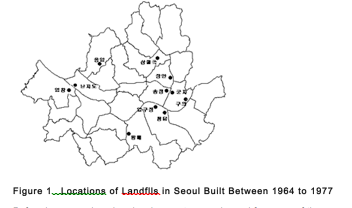
Only a few decades ago, in the early 1960s, Seoul had no designated areas for dumping waste. Since construction materials were expensive in those days, the city of Seoul disposed of household garbage by selling it to private developers who used it in embankments. The amount of garbage sold by the city accounted for 57% of the total waste generated in 1971 and 40% in 1974. Meanwhile, the booming domestic manufacturing industry and consumption, emerging as a result of Korea’s rapidly growing economy, resulted in generation of waste on a massive scale. This is evidenced by the fact that in 1977 the city was generating 7,000~14,000 tons of waste every single day. Waste management was becoming a critical urban issue that needed addressing.
Seoul undertook a landfill construction project to accommodate this exponentially increasing waste. From 1964 to 1977, landfills were constructed at the outskirts of the city and included Gunja, Sangwolgok, Eungam, Yeomchang, Bangbae, Apgujeong, Jangan, Gueui, Cheongdam, Songjeong and Nanjido. (See Figure 1)
.png)
Since garbage was piling up in Nanjido Landfill, which was running out of space, an 89-meter high soil wall was constructed along the site with recycled construction materials and briquette ashes to add extra capacity in 1985. When the landfill was finally closed, it held 92 million m³ of trash: a massive pile of garbage at the first site 92~94 meters in height, and 97~99 meters at the second site. As the exhaustion of Nanjido Landfill raised public concern about its impact on the environment and human health, securing a new landfill site became an urgent urban issue.
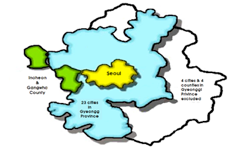
SOLUTIONS
2.1. Planning
1) Site Selection
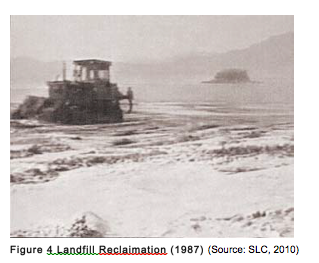
2) Plans for Creation of Sudokwon Landfill
2.2. Implementation
1) Coordination Committee for Sudokwon Shore Landfill (1984)
2) Sudokwon Landfill O&M Union (1991)
To improve management of the completed landfill sites, organizational restructuring was suggested. With the Environmental Management Corporation taking over affairs related to the already completed landfills, Sudokwon Landfill O&M Union was launched for joint management and operation of Sudokwon Landfill Site on November 11, 1991.
3) Sudokwon Landfill Site Management Corporation (SLC)
2.3. Fiscal Structure
1) Securing Land & Funding for the Landfill Site
Cost sharing arrangements between the involved regional governments for the construction were made by the Coordination Committee for Sudokwon Shore Landfill at a ratio of 100:16:16 (Seoul: Incheon: Gyeonggi-do). Each region’s share for reclaiming the site was apportioned on the basis of their 1998 population. In detail, expenses covered by the SMG included KRW 27.3 billion for acquiring the land, KRW 25.6 billion for the first landfill construction, KRW 24 billion for the installation of other facilities, and KRW 25.2 billion for the second landfill.

2) Revenue
3) Expenditures
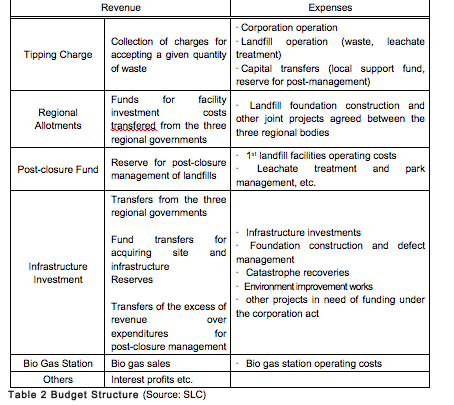
2.4. Challenges
1) Local Opposition
When Sudokwon Landfill Site was being created, resident opposition was not as strong because the region had a much lower population at the time. Soon, however, the region within five kilometers of the site would see a spike in population, which exacerbated conflict between residents and the authorities; as of 2013, there were 200,000 residents in a town which had only 20,000 in the 1980s. As residents became more aware of the environmental impact of the nearby factories, their concerns also grew over possible degradation of their living environment from facilities for sludge and leachate treatment and gas generation, etc.
A variety of actions were taken to address issues which had grown out of misunderstanding and distrust. To gather the opinions and complaints of area residents, the authorities organized a Sudokwon Landfill Site Operating Cooperative and discussed affairs related to construction and operation of the landfill and community support projects. Residents were encouraged to take part in site inspections and a monitoring program set up for them. Later, upon creation of the SLC, an operating committee consisting of community representatives was established to collect resident opinions and provide support where needed. In addition, a community support fund was set up to provide funding for improving the living environment and quality of life in the potentially-affected areas. These approaches seek to minimize negative impact of the landfill site on public health and community environments and promote greater harmony with people living in the area.
2) Conflicts between Regions over Landfill Extension
As the government has consistently reduced the amount of trash, the city generates and improved waste management, the share of waste going into landfill has substantially decreased. This, however, has created conflict between the SMG and the Incheon Metropolitan Government over extending the life of Sudokwon Landfill. The SMG, which enjoys the support of the Ministry of Environment, has insisted on continuing the site’s operation until 2044, while the Incheon Metropolitan Government wants it to stop taking trash in 2016 as originally planned. While initially in favor of extending operations and pursuing construction of the third landfill onto the existing site, Incheon has changed its views due to a public outcry from area residents. (Lee et al. 2013)
Successful management of conflicts between different entities depends on mutual understanding built through negotiations. Appropriate strategies can minimize local opposition to extension of the existing facilities. While the government is trying to reduce reliance on landfill sites, the SLC has successfully provided residents with a greener waste management service so far.
Results
1) Acquisition of the World’s Largest Sanitary Landfill
On 20 million m² of land, Sudokwon Landfill Site is the world’s largest. With its environmentally-friendly management and advanced waste management technologies, the adverse effects of landfill have been greatly reduced; it has created a more pleasant living environment for local residents. As a consequence of relentless efforts to sophisticate leachate and waste treatment techniques, the site’s accomplishments have been recognized worldwide
2) Profit Generation through Resource Recovery
With the ongoing investment in development of high-tech landfill technologies, as much effort is going into making waste management more environmentally-friendly through waste-to-energy initiatives. Methane gas from buried garbage is utilized as a source of energy and sent to the turbine to provide power to the landfill site. Surplus methane gas is treated by the central incinerator to prevent greenhouse gas emissions. Altogether, SLC is expecting a substantial profit through reductions of 1.21 million tons of CO² per year and also from sales of carbon credits.
3) Dream Park
The closed first landfill has been successfully rehabilitated into the largest eco-friendly park in Korea.
This massive public amenity works to protect wildlife and features arboretums and hands-on learning for its visitors. Dream Park, which took four years to build, was promoted as part of the SLC's environmental projects designed to restore nature at the site. The park has already become a popular tourist attraction.
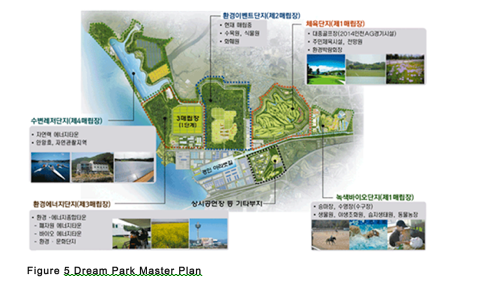
3.2. Outcomes
1) Laying the Groundwork for Better Waste Management Policy
Since its operation, foul odors, dust, harmful insects and toxic leachate from the site has resulted in many complaints from residents. As one countermeasure, the landfill decided to cut its nighttime operations. This decision faced opposition from regional governments and cleaning companies, but after the community consultation process it gained more acceptance and was finally put in place in May 2000. As a result, the safety hazards and issues related to 24-hour operation were greatly improved along with resolving unauthorized nighttime dumping problems.
Effective waste management depends on achieving greater mutual understanding amongst stakeholders. When an organization becomes fragmented, it requires more work to deliver support to the residents and to respond to local needs. SLC’s communication platform for residents is streamlined to facilitate execution of community support projects and foster cooperation with area residents. On the other hand, since establishment of the community support fund, residents are allowed to engage directly in planning for community improvement projects.
2) Engaging Residents in Landfill Management
Dealing with community opposition has never been an easy task, but SLC has made outstanding progress by providing relentless community support and communicating with local residents. Community monitoring agents work on behalf of the community to act as watchdogs and ensure fair waste management practices. Launching the Sudokwon Landfill Site Resident Support Council, the SLC actively seeks civic participation in community briefings to communicate waste policies between the community and the related authorities.
As residents are able to directly engage in management of the landfill, their ideas and opinions on major issues are reflected in the decision-making process, such as their relocation from the area of direct influence and prevention of illegal waste intake. In addition, the SLC holds a variety of projects designed to enhance the community’s quality of life.
Lessons Learned
1) Rehabilitating the Landfill Site into a Park
Alongside a well-maintained sanitary landfill, expired landfill has been reclaimed for an environmental theme park, a 36-hole golf course, soccer fields and tennis courts. An environmental energy town will be powered by renewable energy and waste-to-energy technologies. Adjacent to other local development such as Incheon International Airport and Gyeongin Ara Waterway, the park is assisting the local economy by attracting tourists.
2) A Sustainable Energy Project under CDM
The Sudokwon Landfill Gas Electricity Generation Project (50 MW) is registered as a Clean Development Mechanism (CDM) project as defined in the Kyoto Protocol. It aims at achieving an LFG collection rate of 75% and power generation of 50W at Sudokwon Landfill Site. It is expected to earn saleable certified emission reduction (CER) credits, which may be traded in emissions trading schemes. CDM projects are expected to assist developing countries in achieving sustainable development. It has to be taken into account, however, that successful implementation of CDM projects requires an approved baseline and adequate monitoring methodology, not to mention advanced technology and experienced personnel.
3) Tackling Organizational Fragmentation with a Consolidated Body
Sudokwon Landfill Site was initially operated and managed by Sudokwon Landfill Site Operation Cooperative made up of staff from the three sharing regional governments. However, the fragmented organizational structure led to poor accountability, disrupted project flows, and low administrative efficiency. In July 2000, under the Ministry of Environment, the SLC was established as a federal venture to streamline management, and has made an impact on the efficiency of management and operation of the landfills, making it a good role model in the waste management sector.
Department / Contact
- International Relations Division / international@seoul.go.kr